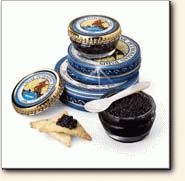|
From
the Caspian Seas
 Russian
caviar is considered to be the creme de la creme of all magnificent caviars. Russian
caviar is considered to be the creme de la creme of all magnificent caviars.
Caviar
itself refers to the eggs of sturgeon...in this case, Beluga, Osetra, and
Sevruga. These are described like so:
Beluga
- These sturgeon weigh as much as 1,800 pounds and are the rarest around.
Thus, Beluga is the most expensive and largest grained of the Sturgeon
Caviars. It has an almost creamy, buttery taste and this is the delicacy
that is served at most prestigious events around the world. It varies in
color from light to dark grey.
Osetra
- These sturgeon are physically smaller than the Beluga (reaching 10 feet
in length and weighing over 500 pounds). Caviar from the Ossetra sturgeon
vary in color from a light golden sheen to a dark brown. The gold Osetra
caviar, known as royal caviar, is the rarest type of Osetra; the flavor
has been poetically described as "nutty" with a hint of "fruitiness"
taste.
Sevruga
- Sevruga sturgeon can weigh up to 160 pounds and reach seven feet in length.
It is the most abundantly available of all the Russian Caspian sturgeon.
Sevruga caviar is small and gray in color.
Caviars
have specific grades, did you know that? Interestingly enough, they refer
to colors and not flavors. They are:
000
(also known as grade 1) - Lightest color, also called 'royal caviar'.
It's the most sought-after and craved by demanding connoisseurs worldwide.
00
(also known as grade 2 ) - Medium dark and gray tone.
0
- Darkest caviar.
Finally,
another term you might uncover when buying caviar online is malossol.
This simply means "lightly salted" in Russian, although today
the term has come to mean any high-quality caviar. It takes great skill
and experience to judge at what stage a sturgeon's eggs are absolutely
right for this process, which should not contain more than 2.7-3% salt.
Caviar
eggs are called "berries." Beluga caviar has the largest
eggs or berries, graded large or coarse. Oestra are slightly smaller, and
Sevruga is the smallest. Depending upon how you want to visually serve
your caviar, this might be a very important criteria to consider.
If
you want to make an impression of caviar that will never fade from your
guest's memory and will leave the feeling of luxuriousness and richness
beyond compare, you want to buy Beluga Caviar. Click on the link below,
and then choose the Caviar button on the left, followed by Tzar Imperial
Beluga Caviar. Remember all you've learned from this site when making
your choice.
That
takes care of Russe Caviar - let's now consider the option American caviar.
Additionally, feel free to explore:
More
Caviar Experiences
Russian
- American
Flying
Fish Roe
Hackleback
Caviar
Paddlefish
Caviar
Salmon
Caviar
Whitefish
Caviar
Baluga
Caviar
Osetra
Caviar
Sevruga
Caviar
Caviar
Grades
Most
Expensive Caviar
How
to Buy Your Caviar
How
to Store Your Caviar
Continue
to enjoy your time here, and don't forget to sign up for my private Finer
Things in Life eZine! You'll receive in email superb recommendations
for treating yourself and your friends the way you deserve....click
here to learn more.
[
Return to top ]
______________________________
|